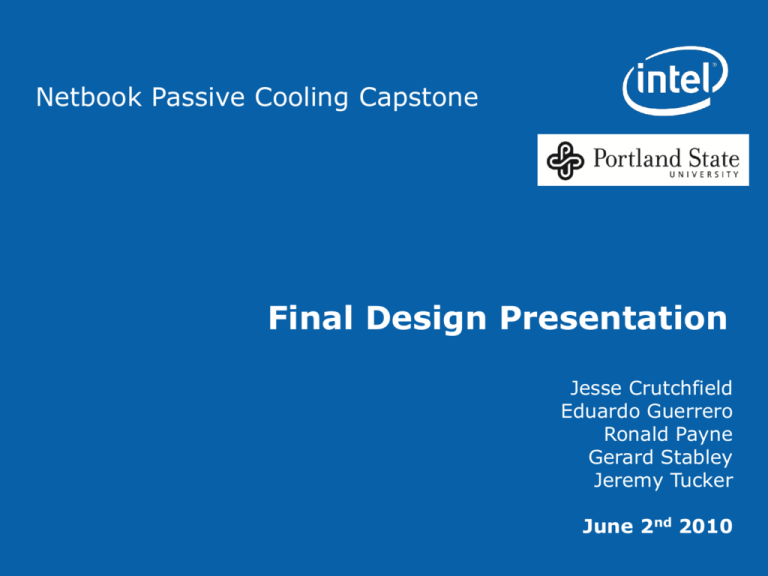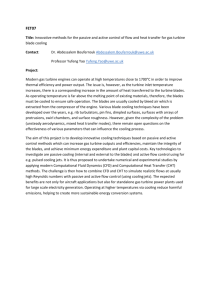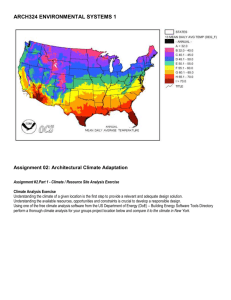Board-Level Thermal Mechanical Reliability
advertisement

Netbook Passive Cooling Capstone Final Design Presentation Jesse Crutchfield Eduardo Guerrero Ronald Payne Gerard Stabley Jeremy Tucker June 2nd 2010 Objective Design and produce a passive cooling solution to replace the actively cooled system of an MSI Wind netbook with: 1. Similar cooling capability as the current active solution 2. Minimal impact to the exterior case design Netbook Passive Cooling 2 Customer Primary customer is Intel Corporation Interested in specific and general applications of a passive cooling solution Netbook Passive Cooling 3 Performance Criteria Meet baseline temperatures and power dissipation • • • Skin temperatures Component temperatures Performance Constraints • No power to be drawn from Netbook • Skin temperatures must not exceed safe limits • Netbook dimensions must remain close to original Netbook Passive Cooling 4 Design and Analysis Infrared (IR) Thermography and thermocouples were used to collect temperature data Solid Modeling and FEA were used in design conceptualization Netbook Passive Cooling 5 Final Design Two part design Graphite Heat Spreader Netbook Passive Cooling Copper Heat sink 6 Final Design Copper Heat Sink Heat sink manufactured from Electrolytic tough pitch Copper, UNS C11000 Thermal conductivity of 388 W/m-K Total mass of .4 kg (.88 lbs) Thermally couples the primary heat sources on the motherboard Netbook Passive Cooling 7 Final Design Graphite Heat Spreader Heat spreader manufactured from eGRAF graphite Spreadershield material Anisotropic thermal conductivity: 500 W/m-K in the X and Y directions, 3 W/m-K in the Z direction Total mass of .035 kg (.08 lbs) Distributes heat across its large surface area, eliminating “hot spots” Netbook Passive Cooling 8 Design Optimization • Solid modeling in conjunction with FEA analysis was used to optimize dimensions of both heat sink and heat spreader. Netbook Passive Cooling 9 Manufacturing • Master CAM was used in conjunction with a 2-axis CNC mill to machine multiple plastic prototypes as well as the final copper heat sink. Netbook Passive Cooling 10 Design Evaluation IR Thermography Max skin temperature increased by 7.4°C on top surface and 11.4°C on bottom surface with passive cooling solution Netbook Passive Cooling 11 Design Evaluation Digital Thermal Sensor The on-board CPU temperature increased by 2°C, and the on-board GMCH temperature increased by 3°C, with the passive cooling solution. Netbook Passive Cooling 12 Design Evaluation Thermocouples CPU temperature increased by 3.8°C, and the ICH by 1.1°C, with the passive solution. The temperature of the GMCH and the RAM increased by 21.8°C and 11.4°C, respectively, with the passive solution. Netbook Passive Cooling 13 Challenges Heat Transfer Calculations Required assumptions that may not reflect actual circumstances No closed form solutions No empirical correlations for our geometry Dimensioning and Tolerancing Designing parts that needed to mate with existing hardware Manufactured Acrylic Prototypes to determine final dimensions Netbook Passive Cooling 14 Conclusion No change in netbook case dimensions and no visible change in outward appearance Component and skin temperatures maintained within acceptable limits No power consumed by cooling solution Bottom line: Passive Cooling Solution Works Netbook Passive Cooling 15 Acknowledgements Dr. Raul Cal, PSU Dr. Faryar Etesami, PSU Jered Wikander, Intel Chris Coleman, Tektronix Michael Chuning, PSU Matt Getz, GrafTech International Corp. Phil Benos, MH&W International Corp. Netbook Passive Cooling 16





